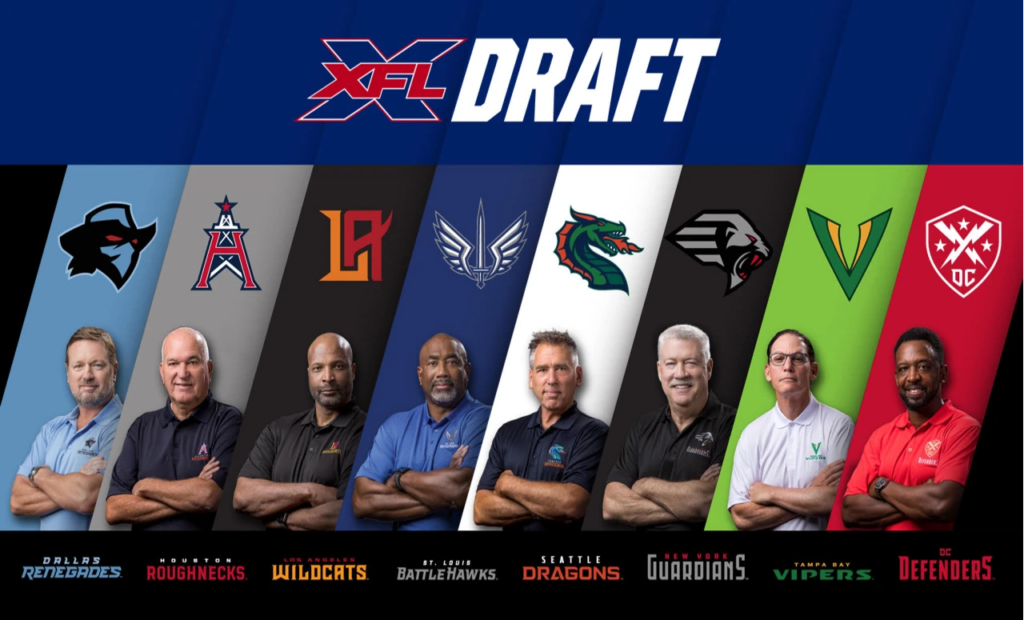Day one of the inaugural XFL Draft is in the books. After three phases and 30 rounds there are now 248 players on XFL rosters, which means the teams are starting to take shape. An additional 240 players will be selected on day two.
With a lot still to digest on which players were selected, how teams are building their rosters, and what it means for the future of each XFL franchise, below are five key takeaways after what was a unique and fast-paced first day of the XFL Draft.
6 OF 8 XFL TEAMS SELECTED QUARTERBACKS IN SKILL POSITION PHASE
Before the start of the XFL Draft, each team was assigned a quarterback:
- Dallas Renegades: Landry Jones
- DC Defenders: Cardale Jones
- Houston Roughnecks: Phillip Walker
- Los Angeles Wildcats: Luis Perez
- New York Guardians: Matt McGloin
- St. Louis Battlehawks: Jordan Ta’amu
- Seattle Dragons: Brandon Silvers
- Tampa Bay Vipers: Aaron Murray
However, each XFL football staff knows that competition breeds success at the game’s most important position, and each team plans to add additional quarterbacks in this draft and in the future.
The first quarterback taken in the XFL Draft was Connor Cook (Michigan State), by the Houston Roughnecks with the second overall pick in the draft. In round two, the St. Louis Battlehawks selected Brogan Roback (Eastern Michigan). Four more quarterbacks were selected in the skill position phase as well in Phillip Nelson (Dallas), Tyree Jackson (DC), Taylor Cornelius (Tampa Bay) and Marquise Williams (New York).
Interestingly, two teams (Los Angeles and Seattle) did not draft a quarterback. Both should be expected to draft at least one quarterback in Day Two’s Open Draft, but passing on a quarterback here could mean any number of things. Do they have multiple quarterbacks they value similarly and decided to wait? Are they highly confident in their assigned quarterback? Is there a different strategic value that head coaches Winston Moss and Jim Zorn have determined?
STRATEGIES DIFFER IN SKILL POSITION PHASE
Even aside from the quarterbacks selected in the skill position phase, each XFL staff clearly built its offensive weapon arsenal differently.
The Dallas Renegades drafted five receivers all under 6-foot and all under 200 pounds, fitting the style head coach Bob Stoops and offensive coordinator Hal Mumme have seen their teams utilize well in the past. Similarly, the Houston Roughnecks used six of their 10 draft picks in the initial phase on receivers, none on tight ends, and three on running backs — one of which has quality pass-catching experience and position versatility in Nick Holley.
However, the Tampa Bay Vipers went in a different direction. They were the first team to draft a tight end (Nick Truesdell from Grand Rapids JC), and they selected two big receivers early in Seantavius Jones (6-3) and Jalen Tolliver (6-3) along with a powerful interior runner in De’Veon Smith.
The DC Defenders also differed from most teams, drafting three tight ends in their first 10 picks, echoing back to head coach Pep Hamilton’s previous offenses at Stanford and with the Indianapolis Colts.
Despite being restricted to just skill position players, each has built a unique and clear identity for its offense.
STORM NORTON, JORDAN MCCRAY HIGHLIGHT APPROACH TO OFFENSIVE LINE PHASE
It may not have been the part of the draft fans cared about, but the offensive line phase may have been the one each XFL staff prepared for the most. And thankfully, the draft pool had an impressive blend of players at each position and ones that can fit multiple schemes.
The Los Angeles Wildcats selected OT Storm Norton (Toledo) with the first overall pick; he has been in camp or workouts with multiple NFL teams, including Minnesota and Miami. The Wildcats, led by offensive coordinator Norm Chow, want to win from the pocket and attack downfield, which is why they put a heavy emphasis on offensive tackles. To note, they selected three with their first four selections, including two over 6-7.
Conversely, the Tampa Bay Vipers were the only team to choose a center in the first round, selecting Jordan McCray from Central Florida, who was most recently with the Chicago Bears. McCray, along with Isaiah Williams in the third round and Andrew Tiller in the fourth, are all high-end interior offensive linemen that fit head coach Marc Trestman’s offensive desire to get the ball out quicker and set his playmakers up for success.
EXPERIENCE AND PASS RUSH ABILITY KEY IN DEFENSIVE FRONT SEVEN PHASE
The Tampa Bay Vipers and St. Louis BattleHawks chose their respective draft positions with the defensive line in mind, and targeted two of the best in the XFL Draft Pool. The Vipers opted for the athletic Obum Gwacham from Oregon State, while the BattleHawks chose interior pressure specialist Casey Sayles from Ohio.
Interestingly, 13 of the first 16 picks in the defensive front seven phase were 25 years or older, showing a focus on experience at the position. Players Gwacham, Sayles, and DC Defenders pick James Vaughters were recently released from NFL teams, but the rest are experienced players from other pro leagues or from the XFL’s workouts.
BREAKDOWN OF DRAFTED PLAYERS BY POWER-5 CONFERENCE
In total, 136 of the 240 players drafted on Day 1 of the XFL Draft were from a Power-5 Conference, meaning over 50 percent of the current XFL roster slate played at the highest level of college football.
The SEC led the way with 18 players in the Skill Position Phase and across all picks on Day 1, while the Pac-12 finished first with 12 players drafted in the Defensive Front Seven Phase, and having the second most players drafted overall thus far.
Here are the number of players taken by conference on Day One of the XFL Draft:
SEC: 38
Pac-12: 27
ACC: 25
Big 12: 23
Big Ten: 23

